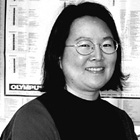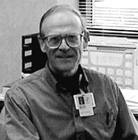
| T H E N I H C A T A L Y S T | M A R C H - A P R I L 1 9 9 8 |
| RECENTLY TENURED | |
Mel DePamphilis received his Ph.D. from the University of Wisconsin at Madison in 1970 and then did postdoctoral work there and at Stanford University Medical School in Palo Alto, Calif.,before joining the faculty at Harvard Medical School in Boston. He was a laboratory head at the Roche Institute of Molecular Biology in Nutley, N.J., and an adjunct professor at Columbia University before coming to NIH in 1996 as a member of the Senior Biomedical Research Service and head of the section on eukaryotic DNA regulation in the NICHD Laboratory of Molecular Growth Regulation.

Mel DePamphilis
|
Most of the work in our lab has focused on DNA replication in eukaryotic cells and on the activation of zygotic gene expression at the beginning of mammalian development.
In the course of our work in developing subcellular systems that support simian virus 40 (SV40) DNA replication and unraveling the sequence of events at replication forks, we identified and characterized RNA-primed DNA synthesis and the enzyme responsible, DNA primaseDNA polymerase We elucidated the assembly and arrangement of nucleosomes in and around the actual sites of DNA synthesis, identified replication pause sites, and elucidated the mechanism of replicon termination.
We have identified a role for transcription elements in viral replication origins and developed methods to map--at nucleotide resolution--the transition from discontinuous to continuous DNA synthesis that defines the site where bidirectional replication begins.
This research led to the first identification of specific initiation sites in mammalian chromosomes and to the discovery that prereplication complexes at these initiation sites can be activated by incubating nuclei from mammalian cells in a Xenopus egg extract. Subsequent work has shown that specific replication origins are established during each G1-phase in proliferating cells.
Current research focuses on identifying the proteins involved in site-specific initiation and on the role of nuclear structure, DNA sequences, and sequence modifications in establishing replication origins at specific genomic sites.
To investigate the requirements for DNA replication and transcription at the beginning of mammalian development, members of my lab have used microinjection and nuclear transplantation techniques.
These techniques revealed that oocytes and preimplantation embryos have the capacity to use specific cis-acting sequences and trans-acting factors to express genes or replicate DNA.
We have identified specific regulatory sequences and transcription factors that are used at the very beginning of mammalian development, and we have uncovered several novel features of zygotic gene activation (ZGA), including: 1) A biological clock delays both initiation of transcription and translation of nascent transcripts until it is time for ZGA. 2) A general, chromatin-mediated repression of promoter activities appears concurrent with formation of a two-cell embryo and ZGA. 3) The ability to use enhancers to alleviate this repression depends on the appearance of a coactivator at the beginning of ZGA. In addition, TEAD-2, a transcription factor that can activate enhancers in preimplantation embryos, is first expressed at ZGA. 4) The mechanism by which enhancers communicate with promoters changes during development. In differentiated cells, a TATA box is required for enhancer-mediated stimulation of promoters, but in undifferentiated cells (for example, mouse cleavage-stage embryos), a TATA box is dispensable and enhancer stimulation is mediated via an Sp1 site. During development, this arrangement allows early enhancer-mediated stimulation of essential promoters that lack a TATA box--such as those governing housekeeping genes--while reducing stimulation later on.
Together, these events impose a directionality at the beginning of animal development that is evident from the inability of fertilized mouse eggs to reprogram gene expression in nuclei taken from cells at developmentally advanced stages. We now aim to identify the roles of specific transcription factors and chromosomal changes in activating key genes at the start of mammalian development.
Peggy Hsieh received her Ph.D. in biochemistry from the Massachusetts Institute of Technology in Cambridge in 1983 and joined NIDDK's Genetics and Biochemistry Branch as a postdoctoral fellow in the laboratory of R. Daniel Camerini-Otero. In 1990, she became a principal investigator in the Genetics and Biochemistry Branch.

|
|
My group's work focuses on mechanistic studies of homologous recombination and DNA mismatch repair. Recombination gives rise to genetic diversity by creating new combinations of genes and ensures the proper segregation of homologues during meiosis, thereby preventing chromosome nondisjunction.
We've been studying a central molecular intermediate in recombination known as the Holliday junction. This remarkably dynamic DNA structure constitutes the exchange point between two DNA molecules and consists of four DNA duplex arms emanating from a crossover point. When flanked by sequence homology, the junction can migrate spontaneously by the stepwise breakage and reformation of Watson-Crick hydrogen bonds as one DNA strand is exchanged for another.
Igor Panyutin, a visiting associate, devised an ingenious experimental system for monitoring movement of the Holliday junction under a variety of conditions. These experiments revealed that branch migration is extremely slow and is blocked by sequence heterologies as small as a single base pair. Panyutin and Indranil Biswas, a visiting fellow, showed that the rate of branch migration is determined by the structure of the DNA at the crossover point.
More recently, Biswas and Akira Yamamoto, a special volunteer, calculated the thermodynamic barrier to branch migration posed by mismatches. These studies highlight the ways in which recombination proteins remove both structural and mechanistic barriers to branch migration. Perhaps our biggest contribution has been to underscore the importance of understanding DNA structures in recombination reactions.
Recombination and repair, like transcription and replication, require that proteins have access to the DNA helix. A long-term goal is to understand how branch migration is propagated through chromatin in the eukaryotic nucleus.
Mikhail Grigoriev, a visiting fellow, has shown that, unassisted, the Holliday junction cannot migrate through DNA organized in a nucleosome however, he recently demonstrated that the Escherichia coli RuvAB protein complex can direct rapid branch migration through a nucleosome in the presence of ATP.
We have now embarked on a search for the eukaryotic DNA "motor" proteins analogous to RuvAB that may propagate branch migration through chromatin.
My interest in DNA mismatch repair (MMR) stems from our work on recombination and mismatched bases. MMR plays a critical role in reducing mutations in almost all organisms, correcting mispaired or unpaired bases that arise through replication errors, physical damage to bases, and homologous recombination.
Recognition of mispaired bases is mediated by the family of MutS proteins that are conserved in species ranging from bacteria to humans. The importance of MMR in reducing mutations is highlighted in its role in cancer biology: Defects in MMR are implicated in hereditary nonpolyposis colon cancer as well as some sporadic tumors.
How does MutS protein recognize mispaired but otherwise normal bases that are constituents of DNA? Biswas isolated a thermostable MutS homologue from Thermus aquaticus and deduced by chemical footprinting studies of a MutS-DNA complex that the protein interacts with both the major and minor grooves of DNA in the immediate vicinity of an unpaired base.
Photo-crosslinking of the MutS-DNA complex has allowed us, in collaboration with Vlad Malkov in Dan Camerini-Otero's lab, to achieve the first identification of a DNA binding region in an MMR protein.
Our studies of recombination and MMR have come full circle, with our work now directed toward the identification of molecular interactions involved in the regulation of homologous recombination by MMR.
Understanding recombination and repair in molecular terms may help us to understand how organisms simultaneously balance the need to ensure diversity and to avoid the accumulation of deleterious mutations.
David Schlessinger received his Ph.D. in biochemistry from Harvard University in Cambridge, Mass., in 1960 and did his postdoctoral work at the Pasteur Institute in Paris. He was professor of molecular microbiology, genetics, and microbiology in medicine at Washington University in St. Louis before coming to NIH in September 1997 as a member of the Senior Biomedical Research Service and chief of the newly established NIA Laboratory of Genetics.

|
Our research program is designed to study events critical for the aging of specialized mammalian cells and concomitant aging-related phenomena.
We are using developmental genomic approaches to analyze inherited genetic conditions and relevant embryonic processes. Throughout the studies we have planned, our work interweaves genomic approaches to aid in developmental analyses, with the further aim of studying physiology in aging populations.
Our current investigations focus on two broad areas. The first is studies of gene regulation in chromatin. Projects are designed to understand tissue- and developmentally restricted expression of the genes which, when mutated, cause Simpson-Golabi-Behmel syndrome and X-linked anhidrotic ectodermal dysplasia (EDA) (see below). The regulatory processes in these cases involve features of chromatin, which we will attempt to study in artificial chromosomes recovered in chromatin form.
The second broad area of our work is the analysis of cohorts of genes involved in selected processes, using a genome approach to developmental phenomena. This approach starts with human inherited conditions and relevant embryological studies in mouse models, in which sets of genes from embryonic stages can be easily mapped in the genome, localized in sections, and studied with knockout technologies. Examples include:
In this case, the key biological questions are how the set-point for organ size is determined and how overgrowth is related to pathophysiology. Our speculative model for the etiology of the syndrome is based on concentrations of insulin-like growth factor II and features of growth hormone action. We plan to test and extend this hypothesis through developmental studies and mouse models.